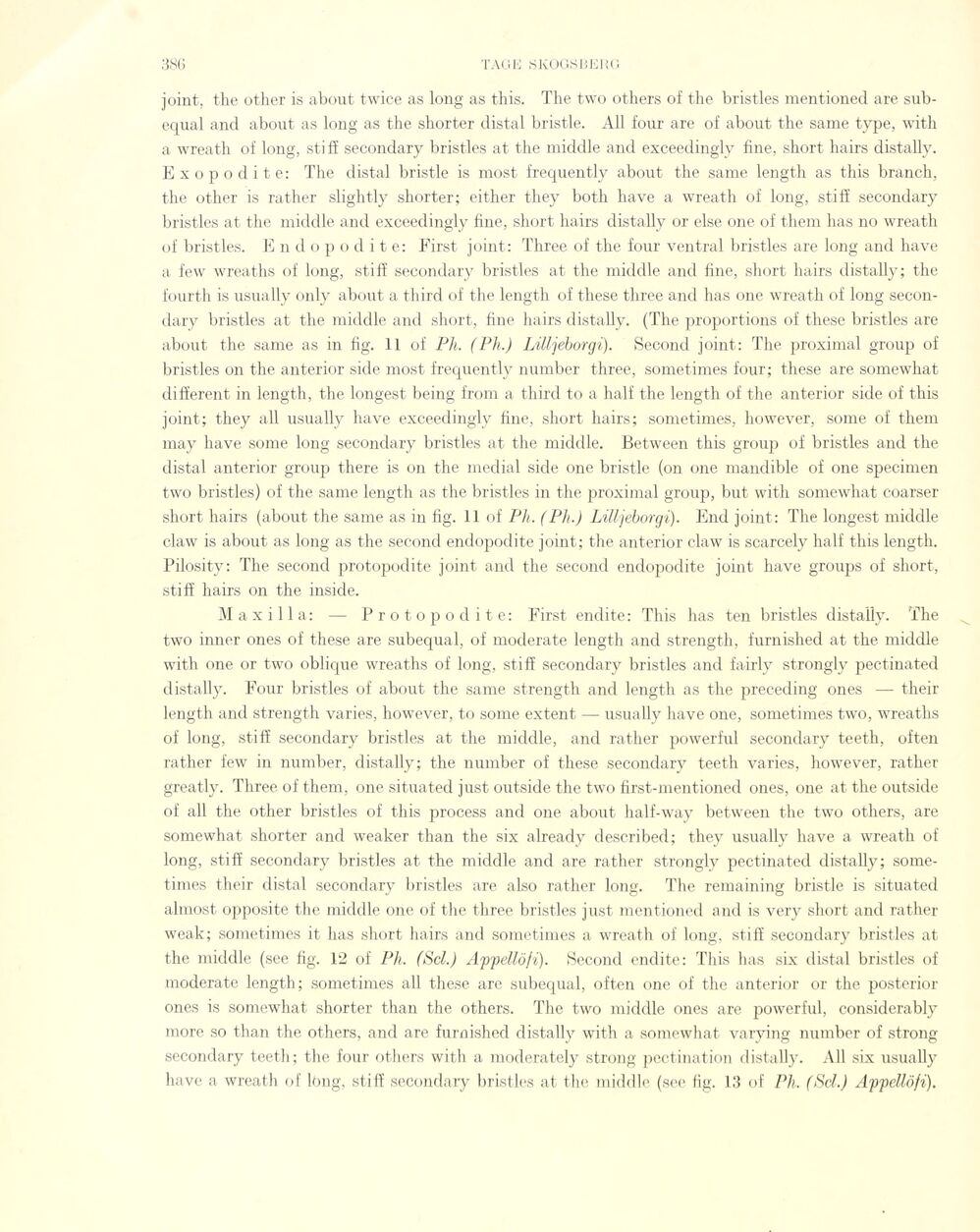
Full resolution (JPEG) - On this page / på denna sida - Sidor ...

<< prev. page << föreg. sida << >> nästa sida >> next page >>
Below is the raw OCR text
from the above scanned image.
Do you see an error? Proofread the page now!
Här nedan syns maskintolkade texten från faksimilbilden ovan.
Ser du något fel? Korrekturläs sidan nu!
This page has never been proofread. / Denna sida har aldrig korrekturlästs.
joint, the otker is about twice as long as this. The two others of the bristles mentioned are
sub-equal and about as long as the shorter distal bristle. All four are of about the same type, with
a wreath of long, stifE secondary bristles at the middle and exceedingly fine, short hairs distally.
Exopodite: The distal bristle is most frequently about the same length as this branch,
the other is rather slightly shorter; either they both have a wreath of long, stifï secondary
bristles at the middle and exceedingly fine, short hairs distally or else one of them has no wreath
of bristles. Endo p odite: First joint: Three of the four ventral bristles are long and have
a few wreaths of long, stifï secondary bristles at the middle and fine, short hairs distally; the
fourth is usually only about a third of the length of these three and has one wreath of long
secondary bristles at the middle and short, fine hairs distally. (The proportions of these bristles are
about the same as in fig. 11 of Ph. ( Ph.) LUI jeborg i). Second joint: The proximal group of
bristles on the anterior side most frequently number three, sometimes four; these are somewhat
different in length, the longest being from a third to a half the length of the anterior side of this
joint; they ail usually have exceedingly fine, short hairs; sometimes, however, some of them
may have some long secondary bristles at the middle. Between this group of bristles and the
distal anterior group there is on the medial side one bristle (on one mandible of one specimen
two bristles) of the same length as the bristles in the proximal group, but with somewhat coarser
short hairs (about the same as in fig. 11 of Ph. (Ph.) Lilljeborgi). End joint: The longest middle
claw is about as long as the second endopodite joint; the anterior claw is scarcely half this length.
Pilosity: The second protopodite joint and the second endopodite joint have groups of short,
stifï hairs on the inside.
Maxilla: — Protopo dite: First endite: This has ten bristles distally. The
two inner ones of these are subequal, of moderate length and strength, furnished at the middle
with one or two oblique wreaths of long, stifï secondary bristles and fairly strongly pectinated
distally. Four bristles of about the same strength and length as the preceding ones — their
length and strength varies, however, to some extent — usually have one, sometimes two, wreaths
of long, stifï secondary bristles at the middle, and rather powerful secondary teeth, often
rather few in number, distally; the number of these secondary teeth varies, however, rather
greatly. Three of them, one situated just outside the two first-mentioned ones, one at the outside
of ail the other bristles of this process and one about half-way between the two others, are
somewhat shorter and weaker than the six already described; they usually have a wreath of
long, stifï secondary bristles at the middle and are rather strongly pectinated distally;
sometimes their distal secondary bristles are also rather long. The remaining bristle is situated
almost opposite the middle one of the three bristles just mentioned and is very short and rather
weak; sometimes it has short hairs and sometimes a wreath of long, stifï secondary bristles at
the middle (see fig. 12 of Ph. (Sel.) Appellofï). Second endite: This has six distal bristles of
moderate length; sometimes ail these are subequal, often one of the anterior or the posterior
ones is somewhat shorter than the others. The two middle ones are powerful, considerably
more so than the others, and are furnished distally with a somewhat varying number of strong
secondary teeth; the four others with a moderately strong pectination distally. Ail six usually
have a wreath of lbng, stifï secondary bristles at the middle (see fig. 13 of Ph. (Sd.) Appellôfi).
<< prev. page << föreg. sida << >> nästa sida >> next page >>